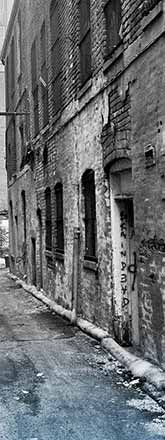Knoxville’s Shadowy Side Up Close*
SCHWARZENBACH: “The giant illuminated letters advertising the
Andrew Jackson Hotel cast their shine into one of these streets so
that I can read the street-sign: West Front Street. Above it, barely visible
on the logs of the old house wall it reads ‘Tavern.’ Later, I was told that
this building is the oldest hotel of old Knoxville, a Knoxville that once
started to develop down here, on the ‘West Front’ of the river.  Today,
this is the quarter for its poorest inhabitants. Pale children play under
the buttresses of the bridge, climb around in the bridge’s frame of steel,
thrive in the shadows. Negro boys, skinny and shivering in their clothes
that are too light, lean against the walls of shacks or creep through the
brush on the riverbank, nonchalantly holding cigarettes in their slender
hands. An Indian woman is breastfeeding her youngest boy whom she
shows to me saying ‘He does not want to live,’ adding ‘I don’t know what
is wrong with him.’”
Today,
this is the quarter for its poorest inhabitants. Pale children play under
the buttresses of the bridge, climb around in the bridge’s frame of steel,
thrive in the shadows. Negro boys, skinny and shivering in their clothes
that are too light, lean against the walls of shacks or creep through the
brush on the riverbank, nonchalantly holding cigarettes in their slender
hands. An Indian woman is breastfeeding her youngest boy whom she
shows to me saying ‘He does not want to live,’ adding ‘I don’t know what
is wrong with him.’”
McCARTHY, Suttree: “Past these gnarled ashcans at the alley’s
mouth with their crusted rims and tiled gaping maws in and out
of which soiled dogs go night and day.”
“Encampment of the damned. The viaduct spanned a jungly gut filled
with rubble and wreckage and a few packing crate shacks inhabited
by transient blacks and down through this puling waste the dark and
leprous waters of First Creek threaded the sumac and poison ivy.”
*NOTE: Panels Fourteen and Fifteen are meant to be viewed together, as an example of the similar impressions had by Schwarzenbach, McCarthy, and Buddy and The Huddle.
Knoxville’s Shadowy Side Up Close*
 SCHWARZENBACH: “The giant illuminated letters advertising the
Andrew Jackson Hotel cast their shine into one of these streets so
that I can read the street-sign: West Front Street. Above it, barely visible
on the logs of the old house wall it reads ‘Tavern.’ Later, I was told that
this building is the oldest hotel of old Knoxville, a Knoxville that once
started to develop down here, on the ‘West Front’ of the river. Today,
this is the quarter for its poorest inhabitants. Pale children play under
the buttresses of the bridge, climb around in the bridge’s frame of steel,
thrive in the shadows. Negro boys, skinny and shivering in their clothes
that are too light, lean against the walls of shacks or creep through the
brush on the riverbank, nonchalantly holding cigarettes in their slender
hands. An Indian woman is breastfeeding her youngest boy whom she
shows to me saying ‘He does not want to live,’ adding ‘I don’t know what
is wrong with him.’”
SCHWARZENBACH: “The giant illuminated letters advertising the
Andrew Jackson Hotel cast their shine into one of these streets so
that I can read the street-sign: West Front Street. Above it, barely visible
on the logs of the old house wall it reads ‘Tavern.’ Later, I was told that
this building is the oldest hotel of old Knoxville, a Knoxville that once
started to develop down here, on the ‘West Front’ of the river. Today,
this is the quarter for its poorest inhabitants. Pale children play under
the buttresses of the bridge, climb around in the bridge’s frame of steel,
thrive in the shadows. Negro boys, skinny and shivering in their clothes
that are too light, lean against the walls of shacks or creep through the
brush on the riverbank, nonchalantly holding cigarettes in their slender
hands. An Indian woman is breastfeeding her youngest boy whom she
shows to me saying ‘He does not want to live,’ adding ‘I don’t know what
is wrong with him.’”
McCARTHY, Suttree: “Past these gnarled ashcans at the alley’s
mouth with their crusted rims and tiled gaping maws in and out
of which soiled dogs go night and day.”
“Encampment of the damned. The viaduct spanned a jungly gut filled
with rubble and wreckage and a few packing crate shacks inhabited
by transient blacks and down through this puling waste the dark and
leprous waters of First Creek threaded the sumac and poison ivy.”
*NOTE: Panels Fourteen and Fifteen are meant to be viewed together, as an example of the similar impressions had by Schwarzenbach, McCarthy, and Buddy and The Huddle.


...the journey seems to me less an adventure and a foray into unusual realms than a concentrated likeness of our existence: residents of a city, citizens of country, beholden to a class or a social circle...
— Annemarie Schwarzenbach —